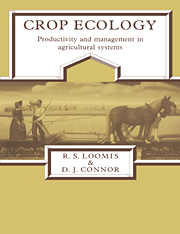Book contents
6 - Aerial environment
from Part II - Physical and chemical environments
Published online by Cambridge University Press: 05 June 2012
Summary
INTRODUCTION
Electromagnetic radiation is a central feature of the crop environment; its energy is the factor that determines soil and air temperatures, wind movements, evaporation, and photosynthesis. Two types of electromagnetic radiation, distinguished by their sources and spectral distributions, are important in crop environments. Solar radiation from a very hot thermal radiator, the Sun, is termed short-wave radiation (SW) because the majority of the energy is received in relatively short wavelengths, 0.3 to 3 µm. Thermal radiation from objects on our planet, including soils, plants, and the atmosphere, on the other hand, occurs at longer wavelengths because the radiating bodies are at much lower temperatures. Such long-wave radiation (LW) is found mainly between 5 and 100 µm.
This chapter examines these radiation sources and their roles in the macro- and microclimates of crops. When long' or short-wave radiation is absorbed by objects in our environment, the temperature of the absorber is increased. That heat energy may remain in the object or it may be radiated as new long-wave radiation, transferred to another object, or dissipated in the evaporation of water. All of these subjects are covered here. We begin with a review of several physical laws important in radiative transfers of energy among plants, soil, and the atmosphere, as well as from the Sun.
RADIATION CONCEPTS
Thermal radiation
All objects with a temperature greater than 0 K are sources of a continuous spectrum of electromagnetic radiation which, because of its source, is termed thermal radiation.
- Type
- Chapter
- Information
- Crop EcologyProductivity and Management in Agricultural Systems, pp. 131 - 163Publisher: Cambridge University PressPrint publication year: 1992



